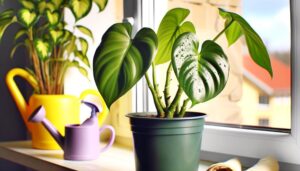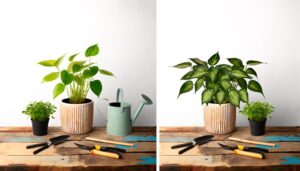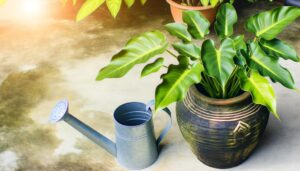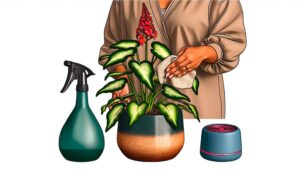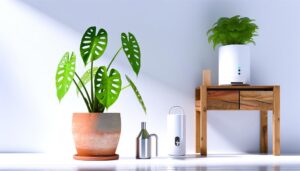What Are the Care Requirements for a Neon Heartleaf Philodendron?
The Neon Heartleaf Philodendron, a Central and South American native, thrives in low-to-medium light, and enjoys a warm, humid climate. Careful temperature and humidity management, including monitoring with a hygrometer, is essential.
This plant prefers moderate watering, allowing the soil to partially dry, and a well-draining soil mix rich in organic matter. Fertilization enhances plant health, while regular pruning encourages growth and aesthetics.
Key to its care, is understanding the need for gradual repotting as well. Further inquiry into this beautiful plant's requirements enables a deeper comprehension of its nuanced regimen.
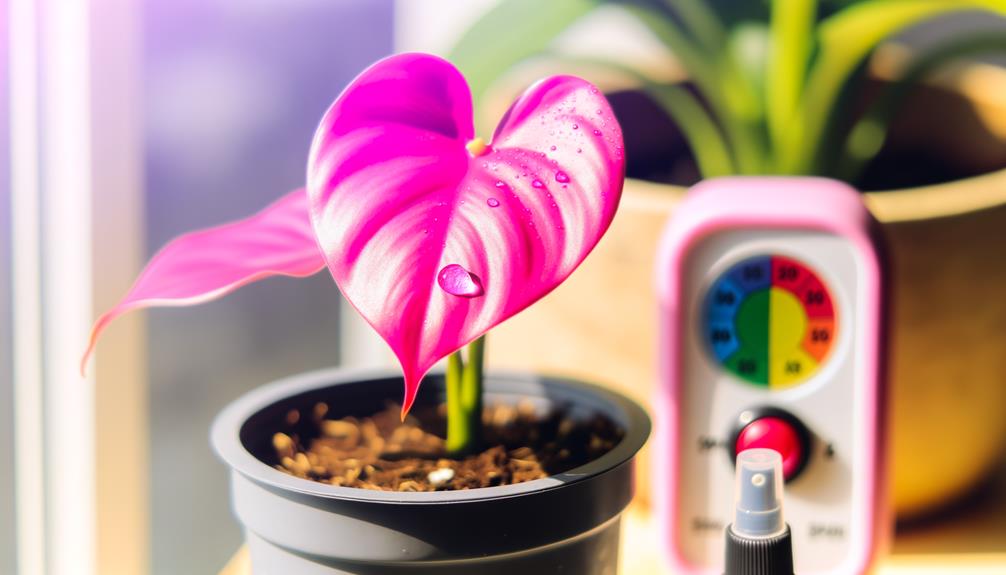
Key Takeaways
- Neon Heartleaf Philodendrons thrive in low-to-medium light with bright, indirect sunlight.
- They require a consistent temperature ranging from 60-75°F (15-24°C) and humidity level between 40-60%.
- The plant prefers moderate watering, allowing the soil to partially dry out before watering again.
- Well-draining soil rich in organic matter and slightly acidic (pH 6.0-7.0) is ideal for this plant.
- Regular pruning, balanced fertilization, and repotting every 2-3 years are essential for its growth and health.
Understanding Neon Heartleaf Philodendron
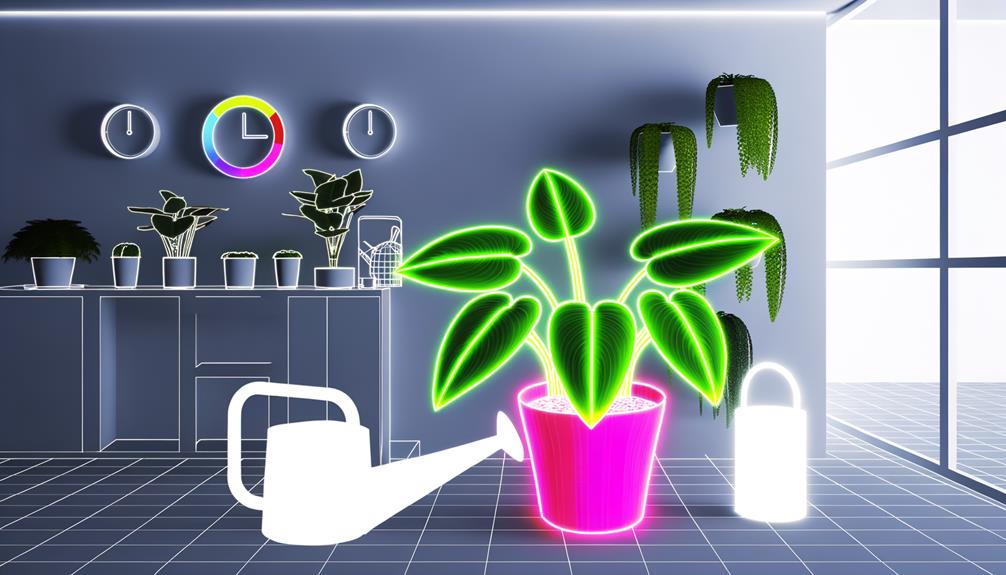
While the Neon Heartleaf Philodendron, scientifically known as Philodendron hederaceum 'Neon', is renowned for its vibrant, lime-green foliage, it is imperative to understand its inherent botanical characteristics and growth habits for successful cultivation.
This tropical perennial plant, native to Central and South America, has adapted to thrive in low-to-medium light environments and prefers a consistently warm, humid climate. It exhibits epiphytic growth habits, often anchoring itself to other plants for support. Its heart-shaped leaves, arranged alternately along the stem, exhibit a unique neon-green color, which intensifies under ideal conditions.
Understanding these biological and ecological characteristics provides the foundation to offer care that aligns with the plant's natural tendencies, thereby promoting healthy and vibrant growth.
Optimal Lighting Conditions
The best lighting conditions for the Neon Heartleaf Philodendron warrant a thorough exploration, given the plant's sensitivity and preference for specific light levels. An understanding of these light levels is essential to ensuring the plant's well-being and enhancing its vibrant neon color.
Additionally, the plant's exposure to direct sunlight must be carefully monitored and managed to prevent any detrimental effects on its growth and overall health.
Understanding Light Levels
In order to maintain the vibrant green hue of a Neon Heartleaf Philodendron, understanding the best lighting conditions becomes crucial; typically, this plant thrives in bright, indirect sunlight. The light intensity greatly influences the plant's photosynthetic activity, with moderate to high levels being most favorable.
However, the nuanced interplay between light quality, duration, and intensity is crucial. For example, while this plant can adapt to lower light conditions, growth may be stunted and the foliage may lose its distinctive neon color. It is advisable to provide a stable source of bright, filtered light to ensure optimal growth.
In the absence of natural sunlight, a fluorescent grow light can be employed to fulfill the photoperiod requirements of this versatile indoor plant.
Avoiding Direct Sunlight
While the Neon Heartleaf Philodendron thrives in bright, filtered light, it should be emphasized that direct sunlight can harm its overall growth and vibrancy. Prolonged exposure to strong sunlight can lead to leaf burn, a harmful condition that manifests as brown, crispy edges on the plant's leaves.
To prevent this, consider the following strategies:
- Place the plant near a north or east-facing window where it can enjoy bright but indirect light.
- Use a sheer curtain to diffuse the sunlight if only a south or west-facing window is available.
- Rotate the plant periodically to guarantee all sides get equal exposure to light.
Ideal Temperature Range
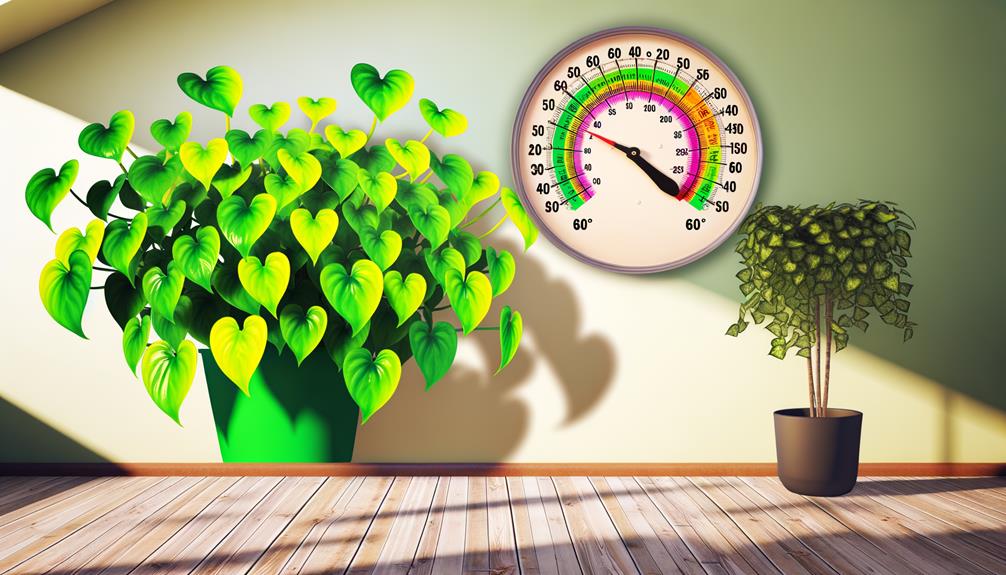
The Neon Heartleaf Philodendron exhibits a preference for specific temperature ranges to optimize its growth and health.
The key focus areas of this discussion will be identifying the optimum indoor temperatures, understanding the plant's adaptability to outdoor climates, and strategies to prevent temperature stress.
Each of these aspects plays a significant role in maintaining the plant's overall well-being and longevity.
Optimum Indoor Temperatures
Maintaining an ideal temperature range of 60 to 75 degrees Fahrenheit (15-24 degrees Celsius) is essential for the best growth and health of a Neon Heartleaf Philodendron. This tropical plant thrives in a controlled indoor environment that mimics its native habitat's temperature range.
Consistent maintenance of these temperature parameters can help prevent health issues such as leaf yellowing, stunted growth, and root rot.
- Consistency is key: Avoid sudden temperature changes, which can stress the plant and potentially lead to leaf drop.
- Monitor your environment: Use a digital indoor thermometer to keep track of your Philodendron's environment.
- Manage heat sources: Be wary of placing your plant near heating or cooling vents, as these can create temperature fluctuations.
Adapting to Outdoor Climates
Although indoor conditions can be more easily controlled, the Neon Heartleaf Philodendron can adapt to outdoor climates, provided the temperature falls within the 60 to 75 degrees Fahrenheit (15-24 degrees Celsius) range, mimicking its native tropical environment.
This resilient plant thrives in warm, humid conditions, and responds poorly to sudden temperature fluctuations. However, it is important to maintain a consistent temperature within the ideal range. Exposing the plant to temperatures outside this range can lead to sub-optimal growth patterns and potential cellular damage, which can be detrimental to the plant's overall health.
Careful monitoring and adjustment of the plant's environment is essential for its successful acclimation to outdoor conditions. Proper care, understanding, and attention to temperature are key to the flourishing of this tropical species.
Preventing Temperature Stress
To prevent temperature stress in the Neon Heartleaf Philodendron, it is vital to carefully regulate the ambient temperature, ensuring it consistently remains within the most suitable 60 to 75 degrees Fahrenheit (15-24 degrees Celsius) range. This plant species is susceptible to damage if exposed to sudden temperature fluctuations, or if it experiences prolonged exposure to temperatures outside its best-suited range.
- Keep the plant in a location where temperature can be effectively controlled, away from direct heat sources or cold drafts.
- Regularly monitor the ambient temperature using a dependable thermometer.
- Adjust the surrounding temperature promptly if it falls outside the ideal range, either by modifying the indoor climate or by moving the plant to a more suitable location.
Adhering to these vital steps will aid in maintaining the plant's health and longevity.
Correct Watering Techniques
In guaranteeing the finest growth and health of a Neon Heartleaf Philodendron, understanding the appropriate watering techniques is of paramount importance. This plant prefers a moderate watering regime, where the soil is allowed to partially dry out between watering. Overwatering can lead to root rot, a common plant disease that can be fatal. Conversely, underwatering can inhibit growth and cause wilting. Use room-temperature water to avoid shocking the plant's system.
For ideal hydration, water thoroughly until it drains from the bottom. This guarantees complete saturation of the root ball, promoting healthy root development. Moreover, watering should be less frequent during winter months, as the plant's metabolic processes slow down in cooler temperatures.
Always check the soil's moisture level before watering to avoid over-saturation.
Essential Humidity Levels
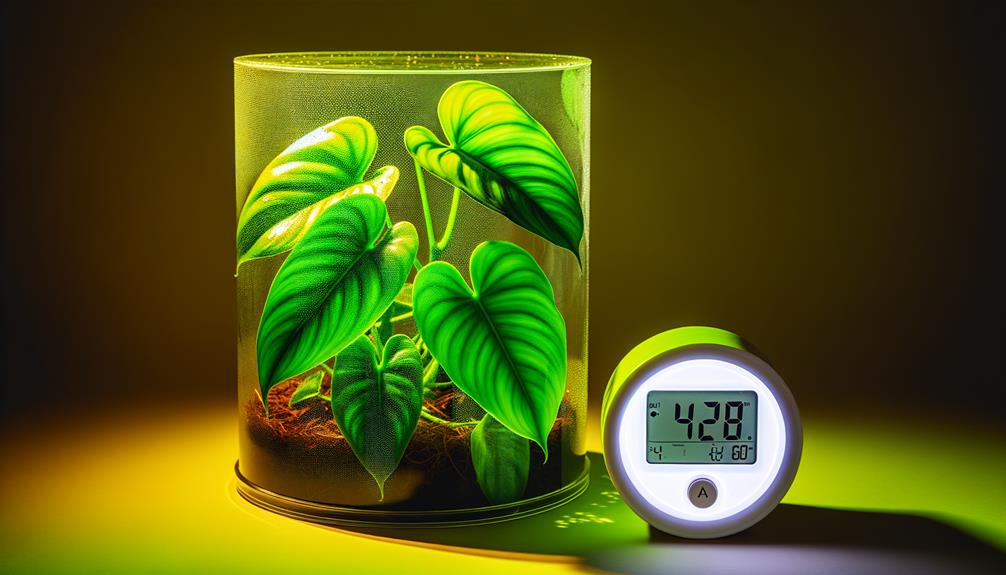
The Neon Heartleaf Philodendron thrives under specific humidity levels, underscoring the significance of discerning its unique needs.
Various methods of humidity control can be employed to maintain these levels, thereby promoting ideal plant health.
However, it's equally important to be mindful of potential humidity damage and implement preventive measures to safeguard the plant's wellbeing.
Understanding Humidity Needs
Philodendron's love for high humidity levels is an essential aspect of its care, as this tropical plant thrives best in a moist environment similar to its natural rainforest habitat. Understanding the humidity needs of this plant will enable you to create an ideal environment for its growth and survival.
- Relative Humidity: Ideally, Neon Heartleaf Philodendron requires a relative humidity of 60-75%. Fluctuations outside this range could lead to leaf browning or slow growth.
- Temperature-Humidity Interplay: Higher temperatures often require higher humidity levels to prevent excessive transpiration.
- Indicators of Humidity Needs: Curled leaves, brown leaf tips, and slowed growth often indicate insufficient humidity.
Humidity Control Methods
Maintaining essential humidity levels for the Neon Heartleaf Philodendron involves implementing specific humidity control methods. This tropical plant thrives in a relative humidity range of 40% to 60%.
A humidifier can be used to raise the humidity in the surrounding environment, ensuring the plant's stomata, or leaf pores, are able to efficiently absorb water vapor. Alternatively, a pebble tray filled with water placed beneath the plant pot can improve local humidity through evaporation.
Regular misting can also be beneficial, but should not be relied upon solely as it only provides temporary humidity. The selection of appropriate humidity control methods is critical for maintaining ideal leaf health and promoting vigorous growth.
One must carefully balance these methods to prevent over-saturation and potential damage to the plant.
Preventing Humidity Damage
Balancing the humidity levels for the Neon Heartleaf Philodendron not only promotes its healthy growth, but also aids in preventing potential humidity damage to the plant. The plant thrives in humidity levels ranging between 60-80%. Deviations from this range can cause damage such as brown leaf tips and reduced growth.
To maintain ideal humidity levels, consider these key points:
- Regularly monitor humidity levels using a digital hygrometer. This ensures the environment stays within the preferred range.
- Strategically place your plant in areas with sufficient humidity, like bathrooms or near humidifiers.
- Regular misting can also help, though it should be carefully done to avoid overwatering.
Adhering to these guidelines will help you prevent humidity damage, thereby fostering the plant's healthy development.
Choosing the Right Soil
Selecting a suitable soil mixture is a crucial aspect in the cultivation of a Neon Heartleaf Philodendron, as it directly impacts the plant's health and growth. The perfect soil should be well-draining and rich in organic matter. A blend of peat moss, perlite, and loam is commonly recommended.
Peat moss enhances moisture retention, beneficial for this tropical species, while perlite ensures proper aeration, preventing root rot. Loam adds essential nutrients, promoting ideal growth. The pH should be slightly acidic, between 6.0 and 7.0. Achieving this balance creates a favorable environment, allowing the Neon Heartleaf Philodendron to thrive.
Thus, attention in soil selection, considering factors like composition, drainage, and pH, plays a significant role in successful Philodendron cultivation.
Importance of Fertilization
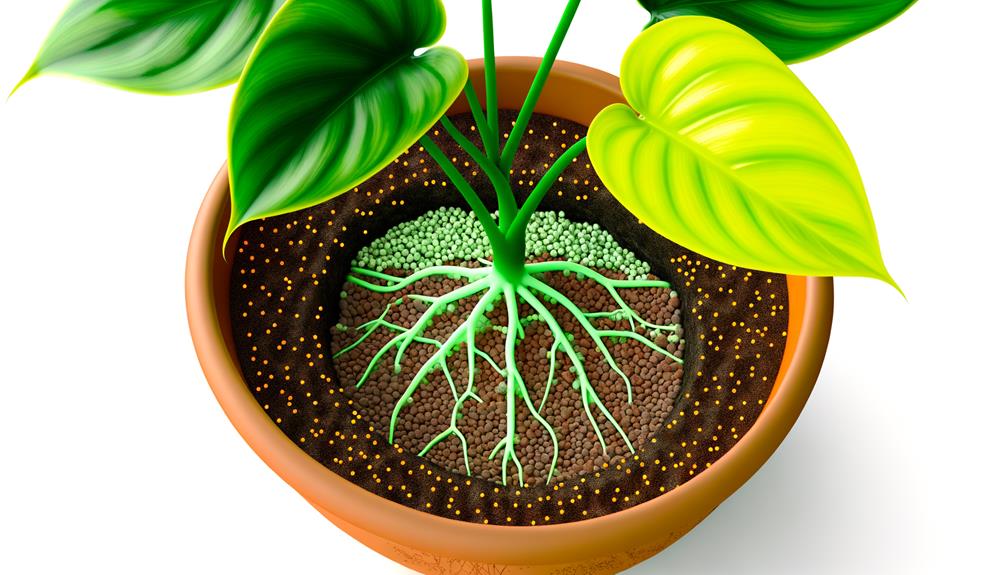
While the right soil composition provides a strong foundation for the Neon Heartleaf Philodendron, proper fertilization is a key tool that enhances its growth and overall health. Fertilization provides the plant with essential nutrients that it may not receive from the soil alone, thereby improving the plant's resistance to diseases and pests, and enhancing its vibrant neon coloration.
Fertilizers help supplement the soil's nutrient content, especially if the soil is lacking in specific nutrients.
Regular application of a balanced fertilizer encourages healthy growth and leaf production.
Fertilization boosts the plant's immunity, fortifying it against common plant diseases and pests.
Fertilization is a critical aspect of Neon Heartleaf Philodendron care that can greatly enhance the plant's aesthetics and longevity.
Pruning and Repotting Tips
To ensure the longevity and visual attractiveness of the Neon Heartleaf Philodendron, regular pruning and timely repotting are necessary procedures that require careful execution. Pruning should focus on removing dead or yellowing leaves to promote healthier growth. Use clean, sharp tools to make accurate cuts close to the main stem, reducing the risk of disease transmission.
Repotting should occur every 2-3 years, or when the plant outgrows its pot. Utilize a potting mix with good drainage to prevent waterlogging. The new pot should be only slightly larger than the previous one, as an excessively spacious environment can lead to root stress.
Proper execution of these procedures, supported by scientific understanding, will enhance the plant's importance and aesthetic appeal.
Pest Prevention Measures
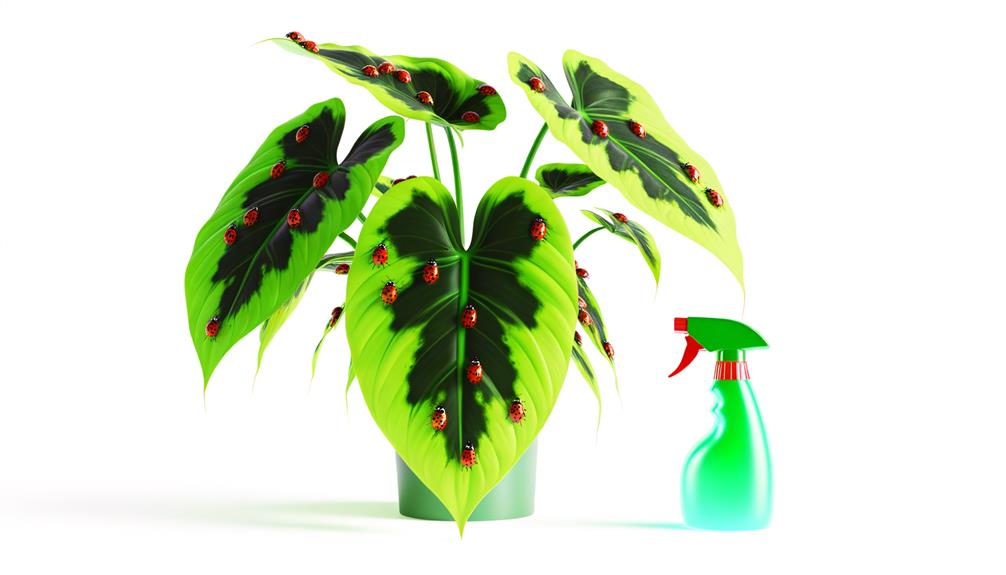
In the domain of maintaining the Neon Heartleaf Philodendron's health, implementing effective pest prevention measures is an essential aspect that warrants meticulous attention and scientific understanding. It's important to adopt a proactive stance towards pest prevention, as neglecting this can lead to irreversible damage.
To safeguard the plant's wellbeing, consider the following strategies:
- Regularly inspect the foliage for signs of infestation, such as discoloration or abnormal patterns. Early detection is key in preventing widespread damage.
- Employ organic pesticides, like neem oil, to keep pests at bay without harming the plant or the environment.
- Ensure ideal growing conditions — sufficient light, balanced watering, and proper ventilation — to strengthen the plant's natural defenses against pests.
Troubleshooting Common Problems
Despite meticulous care and maintenance, the Neon Heartleaf Philodendron may still encounter certain issues, necessitating the need for precise troubleshooting techniques to ascertain and address these challenges.
The most prevalent problems include leaf yellowing, browning, and wilting, often symptomatic of overwatering or lack of adequate light. Proper diagnosis demands a thorough evaluation of the plant's environment, including light exposure, watering frequency, and soil composition.
For instance, to address leaf yellowing, consider moderating water application, ensuring the soil is well-drained, and the plant has access to indirect, bright light. Conversely, leaf browning might indicate low humidity levels, necessitating the need for regular misting or placement of a humidifier.
Conclusion
The Neon Heartleaf Philodendron, with its captivating charm, demands careful attention to thrive. By guaranteeing ideal lighting, controlled temperature, and careful watering, the plant can flourish.
Regular fertilization, strategic trimming, repotting, and diligent pest prevention are also essential. Facing challenges, grasping the core of the issue and dealing with it promptly can result in a vibrant, healthy plant.
As a result, a thorough understanding of these care requirements can greatly enhance the growth and longevity of a Neon Heartleaf Philodendron.

